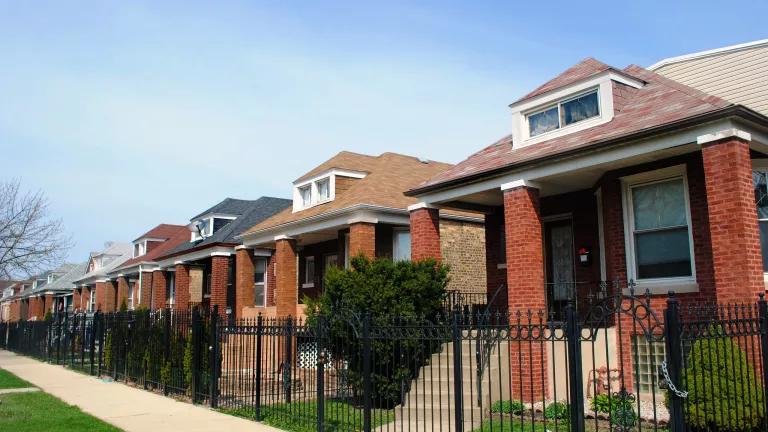To Cool Down the Planet, Make Efficiency Cool: EE Day 2018

This blog was authored by NRDC intern Jillian Aicher, a student at Georgetown University.
Energy efficiency may not be trendy (like saying no to straws) or edgy (like joining a protest), and it certainly isn’t high on the list for most young Americans when we think about small- or large-scale solutions to protect the Earth. But it should be.
The fact is energy efficiency is a game-changer when it comes to tackling climate change and improving public health and clean air, as well as lowering energy bills and creating jobs. There’s no downside to smarter energy use—unless you count the lower costs on your utility bill. So what’s the holdup? One of the most striking aspects of energy efficiency is its sheer amount of untapped potential.
That’s where you and Energy Efficiency Day can help. This daylong celebration, in which advocates, companies, government agencies, and utilities promote efficiency, takes place each year on October 5.
More than 300 individuals, corporations, and local governments—including 30 cities, counties, states, and the U.S. Senate—participated last year, helping educate and raise awareness about efficiency’s importance. This year’s turnout could—and should—be even better. You can participate by doing things as simple as tweeting or writing about efficiency on Facebook on October 5—or replacing one older light bulb with a far more efficient LED model.
In preparation for the third annual Energy Efficiency Day, here are four small-scale steps people—including (and especially) young people—can take to conserve energy, cutting both harmful pollution and wasted money in simple ways:
1. Use power strips, then power down
Every time you charge your phone or watch TV, the electricity used to power your device may coming from a fossil fuel plant that emits pollution. That pollution, in turn, warms the climate and dirties the air. Power strips that supply electricity to many devices at once can be turned off or unplugged, making it easy to stop wasting that energy when the devices are not in use. A good example would be the TV and what’s linked to it, such as a sound bar, and video console. So next time you post a nature picture on Instagram or fawn over Planet Earth on TV, make sure you’re considering the emissions behind those actions too. Make it a habit to conserve some of that power (and money) by unplugging when you call it a night.
2. Stream smart
Streaming movies through gaming devices like Xbox is fairly common, easy, simple…and insanely wasteful. What the gaming companies haven’t told you is that streaming through video game consoles takes 30 to 40 times more power than a dedicated streaming player (like Apple TV or Amazon Fire TV). That’s money falling out of your pocket, and otherwise useful energy going to waste. Long story short, don’t let your Netflix habit make you unknowingly contribute to climate change—or your own financial downfall.
3. Don’t be left in the dark
Switching to LED lightbulbs is one of the easiest (and cheapest) ways to reduce your energy footprint, even if you’re living in a shoebox dorm room or a crowded college-house. LEDs last 10 to 25 times longer and use 85 percent less energy than incandescent bulbs—and switching just five bulbs could save $75 per year. Plus, they’re cheaper than ever, so why not?
4. Save in nice weather
Late summer and early fall weather are great for a lot of reasons, including endless opportunities for easy efficiency. First saving tip: cook outside! Not only is it fun, it also avoids having to use more energy to cool the kitchen back down after cooking inside. Second, help keep the sun’s heat out during the day by closing windows and pulling down the blinds or closing curtains. If you live in an area where the temperature cools off after dark, turn off your cooling system and open windows to let the evening air do the trick. And finally, hang your clothes outside instead of using an energy-consuming dryer. Jean jackets and record players are back in style—it’s time for clothes lines to reclaim their moment in the sun.
Along with these habits, there are plenty of ways to contribute to the bigger picture:
- Ask your local government to issue an Energy Efficiency Day proclamation. (Click on this link to learn how.)
- If you need new gadgets, check out this great site to make sure you get the most efficient one at the lowest cost (You don’t have to be a customer of this utility to use the website). Or look for the ENERGY STAR® label that signifies products are even more energy efficient than required.
- Publicly support energy-saving building codes and encourage your elected officials to adopt them.
- Support federal efficiency standards (and state ones, too) for appliances, electronics, and equipment.
- Attend public listening sessions, if they’re held in your area, or contact your governor to talk about transportation challenges and provide policy input on cleaning up transportation in your state.
- Never stop learning about energy efficiency. There’s a lot to know, but first and foremost is this: Every question, and every action, counts.
So join the ranks—put your name among those pledging to make positive changes through participation in Energy Efficiency Day. On October 5, efficiency efforts large and small will be commended.
Maybe energy efficiency isn’t cool (yet.) But it has the serious potential to keep our planet cool—and that’s what matters. So next time you refuse that straw at the bar (go you!) consider thinking about your energy habits when you return home, too.



